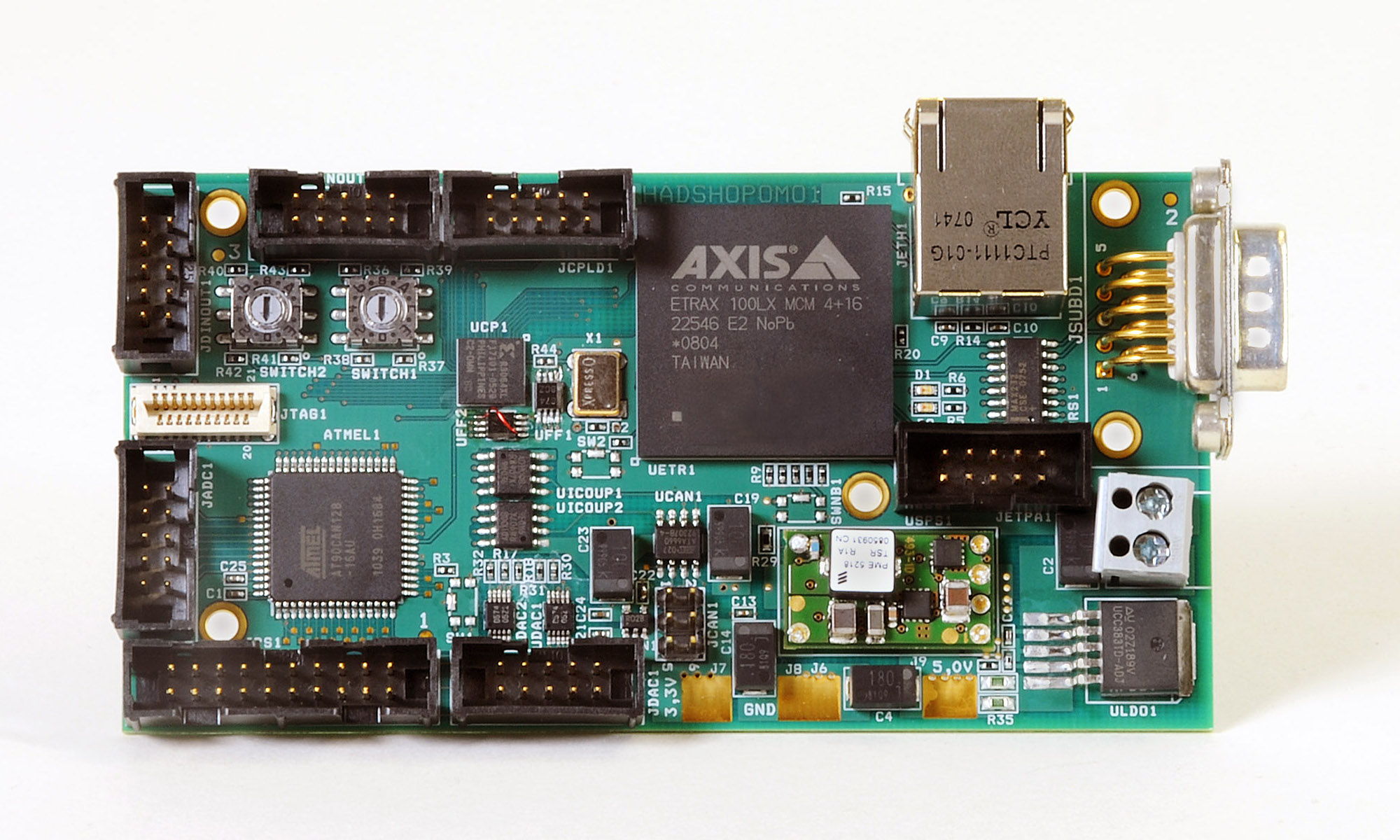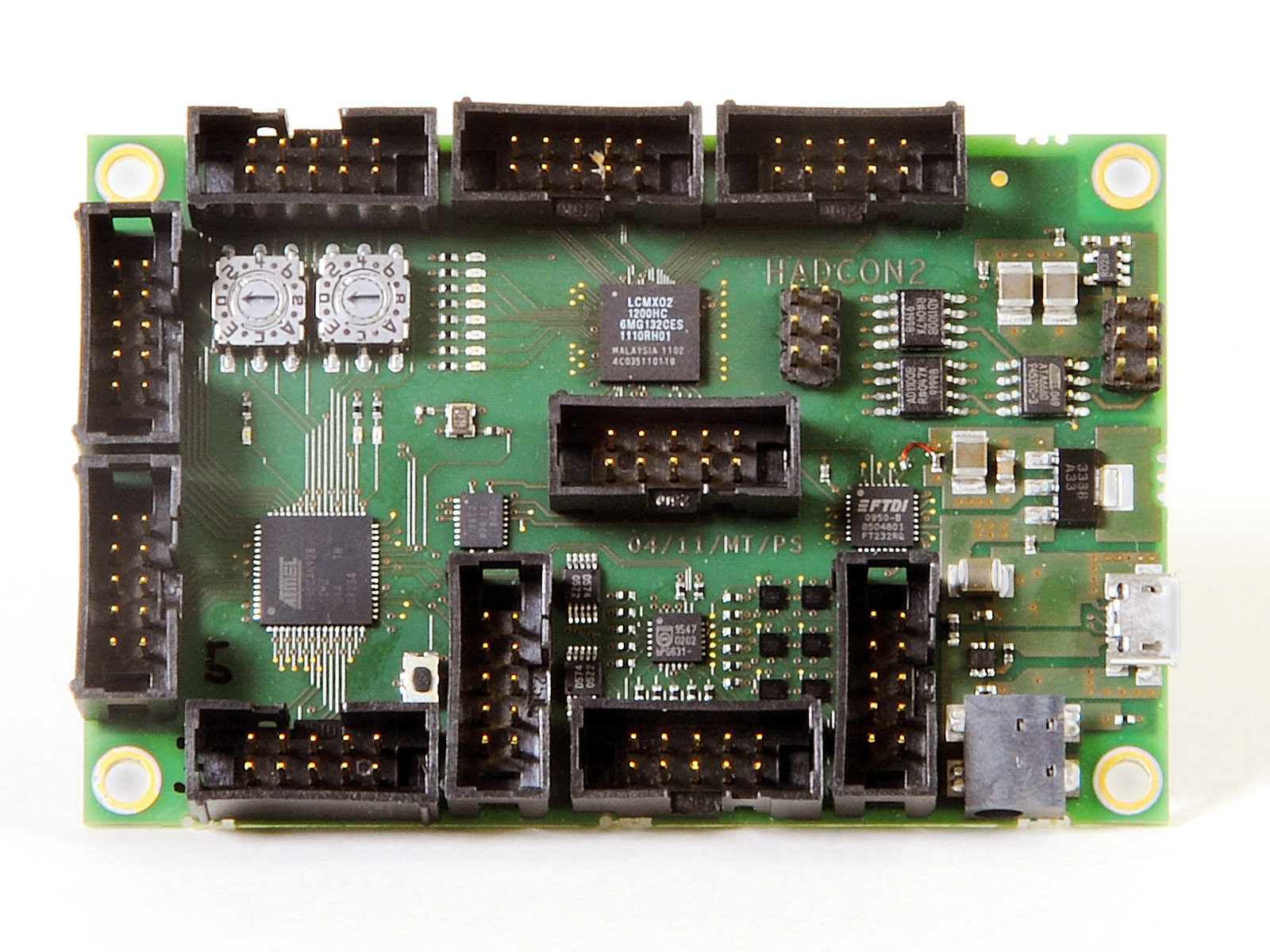
Device Driver/device support modules and Interfaces
- Summarizing:
- CPU: AXIS ETRAX 100LX MCM 4+16
- Microcontroller: ATMEL AT90CAN128
- I2C (internal)
- 2 × 4-channel 8-Bit DAC - Digital-to-Analog Converter
- CANbus
- galvanically isolated CAN - High-speed CAN Transceiver
- optional external power supply
- galvanically isolated CAN - High-speed CAN Transceiver
- SPI
- ADCs
- RS232
- 32 digital I/Os
- I2C (internal)
- CPLD: Xilinx XCR3064XL-6CS48C
- 2 × Rotary Code Switches, hexadecimal coding
- Ericsson PME 5218TS switching regulator for up to 6A 3.3V power usable for other boards
- full EPICS support
- CANbus (based on the thesis and work of L.Fouedjou, see Project Page)
- One-Wire bus implementation
- ADC
- DAC
- Temperature
- Switches
- HadCon's internals
- DACs
- ADCs
- ...
- Summarizing:
- Microcontroller: ATMEL AT90CAN128
- I2C
- CANbus
- SPI
- ADCs
- ...
- FPGA: Lattice MachX02-1200-HC
- FTDI USB to serial UART interface
- USB 2.0 connector
- Power over USB
- I2C devices
- 6 × Single-Channel 1-Wire Master
- 1 × 8-channel I2C-bus multiplexer with reset
- 2 × 4-channel 8-Bit DAC - Digital-to-Analog Converter
- galvanically isolated CAN - High-speed CAN Transceiver
- optional external power supply
- 2 × Rotary Code Switches, hexadecimal coding
- Reset Button for ATMEL
- 11 × LED's, free programmable
- Microcontroller: ATMEL AT90CAN128
- ATMEL's internal
- ADC, SPI, CANbus, I2C, Registers
- Communication with MachX02
- I2C
- 1-Wire bus implementation via I2C
to access 1-wire sensors and actuators:- ADCs
- Temperature sensors
- Switches
- DACs
- 1-Wire bus implementation via I2C
- Relay applications
- ...
- use Beckhoff devices
- be accessed via modBus
- be controlled via EPICS
- be displayed, e.g. with CSS
- (offered to be) used for TASCA, CBM, HADES
- UPDATE
- Meanwhile the project became more detailed, since CBM showed interest to have a RICH mirror setup motor controlled. This setup requires to have 2 servo motors with a gear reduction to tilt a gimbal mounted planar mirror element (400 mm × 400 mm) in 2 directions. It is foreseen to use this setup during CBM's next test beam time.
- TASCA
- Until the ordered parts have arrived, we could use spare equipment of TASCA to develop and test. Thank you.
EPICS DIM interface
The basic idea of this device support module for EPICS is to provide an interface to the DIM protocol in order to read/write EPICS data seen from the DIM world and to act from EPICS as client/server for services and commands in the DIM regime.... see EPICS DIM interface for further information.
Status: running system, documentation: 50%
-- PeterZumbruch - 2017-05-29
DABC extension to the EPICS DIM interface
Based upon the existing EPICS DIM interface several data structures provided by DABC (Data Acquisition Backbone Core) transporting values together with additional attributes, similar to EPICS records, via the transport mechanisms of DIM should be able to be accessed from EPICS via an extension to the above mentioned original interface.... see DABC extension to the EPICS DIM interface for further information.
Status: project init phase, documentation: 5%
-- PeterZumbruch - 2011-03-10
HADCon(trol) / TRB based controls
The HADCon(trol) general purpose board provides access to many external interfaces and devices. This section is about interconnecting those with the EPICS technology.Temperature measurement HADCon(trol)
The HADControl general purpose board provides access to many external interfaces and devices.The task is to replace the already running ansatz of the HADES MDC Gas Monitor temperature measurement by a pure EPICS based design.
... more see Project Page
Status: implemented:100%; documentation: <10%
-- PeterZumbruch - 2013-03-21
CANbus implementation on HADCon(trol) and control via access
The objective of this project is the implementation of a software on the HADCon(trol) board's AVR micro controller. This software enables the control of AVR micro controller's CANbus Interface using an (ASCII based) Application Programming Interface (API). Integrated via streamDevice driver into EPICS the control of CANbus devices will be possible within EPICS.... more see Project Page
Status: implemented 90%; documentation:50% :
-- LindaFouedjio - 2009-02-19
Multi-purpose control implementation on HADCon(trol) for HADES
HadCon is a general purpose IO module for detector and experiment control as well as for small data acquisition systems. (HADControl general purpose board)
Since its first application has been a power monitor for the Hades Shower Detector it has been formerly introduced and well known as HadShoPoMo (Hades Shower Power Monitor (HADControl/HadShoPoMo general purpose board).
(HADControl general purpose board)
Since its first application has been a power monitor for the Hades Shower Detector it has been formerly introduced and well known as HadShoPoMo (Hades Shower Power Monitor (HADControl/HadShoPoMo general purpose board).HadCon has an SoC on-board, ETRAX 100LX MCM 4+16 from AXIS (Wikipedia: en/de) - which will be discontinued, see the new HadCon2. Running a standard Linux the Etrax provides "Connectivity to the world" via TCP/IP.
On the other side it connects via its internal serial interface to an ATMEL AT90CAN128 microcontroller and optionally to an Xilinx CPLD.
Via this junction the ATMEL provides a multitude of possible connections to field buses and general I/O ports. EPICS base and its applications, modules, and extensions can be cross-compiled to run on Etrax Axis' CRIS architecture (see section Architecture: ETRAX's CRIS by AXIS
... more see Project Page
Status: implemented 50%; documentation:10% :
-- PeterZumbruch - 2010-04-21
Multi-purpose control implementation on HADCon(trol) 2 for HADES
HadCon2 is a credit-card sized general purpose I/O module for detector and experiment controls as well as for small data acquisition systems.
 It is the successor of the discontinued first version HadCon ( HADControl/HadShoPoMo general purpose board, HadCon @ Epics Wiki).
The module has an ATMEL AT90CAN128 microcontroller providing a multitude of connectivity:
It is the successor of the discontinued first version HadCon ( HADControl/HadShoPoMo general purpose board, HadCon @ Epics Wiki).
The module has an ATMEL AT90CAN128 microcontroller providing a multitude of connectivity:
It doesn't have any CPU on board, but a USB connector to directly allow communication with any type and size of computer (e.g. PC, raspberry PI, dreamplug, ...) having an USB port on one side and at the other end the microcontroller and the FGPA. This communication is based on an ASCII-based protocol in view of easy implementation in detector control systems like e.g. EPICS and LabVIEW.
 It is the successor of the discontinued first version HadCon ( HADControl/HadShoPoMo general purpose board, HadCon @ Epics Wiki).
The module has an ATMEL AT90CAN128 microcontroller providing a multitude of connectivity:
It is the successor of the discontinued first version HadCon ( HADControl/HadShoPoMo general purpose board, HadCon @ Epics Wiki).
The module has an ATMEL AT90CAN128 microcontroller providing a multitude of connectivity:
I2C (8/4 fold (intern/extern) multiplexer), 6 channel 1-wire master, 8-channel 8bit DAC, galvanically isolated CAN - high-speed transceiver, 8-channel 10-bit SAR ADC, byte-oriented SPI, in total up-to 53 programmable I/O lines and optionally a Lattice MachX02 FPGA for fast data processing tasks.
While the discontinued precursor HadCon had an SoC on-board, its successor HadCon2 has broken up this concept in favour of a more open access:It doesn't have any CPU on board, but a USB connector to directly allow communication with any type and size of computer (e.g. PC, raspberry PI, dreamplug, ...) having an USB port on one side and at the other end the microcontroller and the FGPA. This communication is based on an ASCII-based protocol in view of easy implementation in detector control systems like e.g. EPICS and LabVIEW.
-- PeterZumbruch - 2014-02-07
Objective
This project's objective is to adopt the project specification made for the API for multi-purpose control implementation on HadCon to the new but very similar hardware of HadCon2. This includes the access to the different devices via an ASCII based protocol. This provides:... more see Project Page
Status: implemented 10%; documentation:30% :
-- PeterZumbruch - 2013-03-21
PLC Industrial Control devices
In this section several industrial control devices running PLC or SPS programs are addressedSattCon 200, ABB, HADES cryo control
-
There is a request of HADES to be able to integrate readings from the control system of their cryo system control into the EPICS control system of HADES Maybe, in a second step, also changing of values is of interest.
Right now the system runs a PLC on an ABB SattCon 200 system, which can be accessed by a Windows based control PC, via the ABB Automation PC-based programming tool DOX 10.
... more see Project Page
Status: evaluation whether it becomes a project - turned out to be not feasible; documentation:10% :
-- PeterZumbruch - 2021-06-23
Beckhoff Device Access via EPICS ModBus
- CBM RICH test mirror positioning system
- Summer Student Project 2011
-
As part of the summer student program 2011 at GSI
this projects objective is to develop, evaluate an exemplary motor control, on basis of basic existing components which will
... more see Project Page
Status: project finished; documentation:75%
-- TanyaTorres - 2011-08-29
-- PeterZumbruch - 05 Oct 2011
This topic: Epics > WebHome > EpicsProjectsAndActivities > DriversAndInterfaces
Topic revision: 2013-03-21, PeterZumbruch
Topic revision: 2013-03-21, PeterZumbruch
 Copyright © by the contributing authors. All material on this collaboration platform is the property of the contributing authors.
Copyright © by the contributing authors. All material on this collaboration platform is the property of the contributing authors. Ideas, requests, problems regarding GSI Wiki? Send feedback | Legal notice | Privacy Policy (german)

